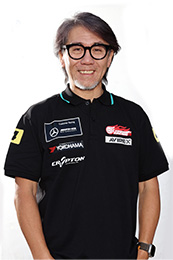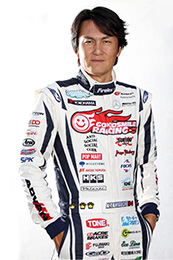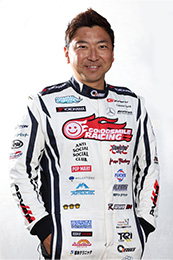GOODSMILE RACING & TeamUKYO RACE REPORT 2
2024 AUTOBACS SUPER GT Round2 FUJI GT 3Hours RACE
The second round of the 2024 SUPER GT season was a three-hour timed race at the Fuji Speedway, held during Golden Week. This was the first time the event used this format.
In 2022 and 2023, the Fuji round featured a 450km endurance race, but this year, the format shifted to a fixed-time race, marking a first in SUPER GT history. Teams were required to make two mandatory pit stops for refueling, and they were allowed six sets of dry tires and seven sets of wet tires for the race.
For this race, the Balance of Performance (BoP) for the Mercedes-AMG GT3 was set at 35 kg, with an additional 39 kg added due to new safety improvements introduced this season, bringing the total weight to 1,359 kg. On top of that, the No. 4 Good Smile Hatsune Miku AMG carried 4 kg of success weight (SW) – 2 kg for each point earned in the season opener at Okayama (2 points × 2 kg).
Additionally, the air restrictors at the Fuji competition, which had previously been set at 36mm x 2, were reduced to 35mm x 2 for this race. In the past, they had allowed teams to run larger restrictors compared to other circuits, making it a favorable track for strong results for the team, but this adjustment has proven to be a significant challenge.
May 3rd [Official Practice, Official Qualifying]
Weather: Sunny
Course: Dry
Temperature / Track Surface Temperature:
Before Q1: 24°C / 35°C
During Q2: 22°C / 34°C
The official practice began at 9:00 a.m. under a perfectly clear sky with Mount Fuji in full view. The temperature was 18°C, and the track surface was 24°C.
As the session kicked off, Kataoka took the car onto the track. On his 6th lap, he set a time of 1 minute 36.853 seconds, putting him 3rd at that point in the session. From there, the team focused on fine-tuning the car’s setup in the pits and testing the two types of dry tires they had brought. After completing 21 laps, Kataoka returned to the pits and handed the car over to Taniguchi.
Taniguchi made minor adjustments to the car’s balance and checked its long-run performance. He consistently lapped in the 1 minute 38 second range before taking a cooldown lap. On his 9th timed lap (the 30th lap overall for No. 4), he recorded his personal best time of 1 minute 37.855 seconds. With 10 minutes left in the class-exclusive session, he handed the car back to Kataoka.
Throughout the official practice, No. 4 maintained the 7th position. However, in the class-exclusive qualifying simulation, we were unable to improve on our personal best time of 1:37.073. As No. 87 (METALIVE S Lamborghini GT3) improved its lap time towards the end of the session, we finished 8th overall with the lap time from earlier in the session.
During the Full Course Yellow (FCY) test at 10:55 a.m., Taniguchi returned to the track, completing nine laps and finishing 12th. In the “Circuit Safari” session at 11:20 a.m., where cars navigate around the GSR Bus, he completed 10 laps and finished 7th, wrapping up the morning session.
This season introduced a new qualifying format, where teams are split into Group A and Group B based on their rankings to compete in Q1. The top eight cars from each group move on to Q2, where they are further divided into the “Upper 16″ and “Lower 17″ groups, depending on their Q1 performance. Final grid positions are then determined by the combined lap times of both drivers. Additionally, the top three teams in qualifying now earn points: 3 points for 1st place, 2 points for 2nd, and 1 point for 3rd.
The order in which Group A and Group B run in Q1 is decided by a lottery drawn by the winning team of the previous race. In the past, the goal in Q1 was simply to finish in the top eight of each group. However, under the new rules, the combined times of both drivers now determine the final standings. This change makes it critical to not only finish in the top eight but also to set the fastest time possible in Q1. The second group to run gains an advantage, as the rubber laid down by the first group improves track conditions.
Additionally, a new rule requires that the “marked tires” used in Q1 must also be used in Q2 and for the start of the race the following day. This forces teams to carefully manage their tires until the start of the race.
In this race, No. 4 was assigned to Group A for Q1, and, just like in the season opener, it was the second group to run. Kataoka was tasked with the first time attack.
At 2:43 p.m., following Group B’s start at 2:25 p.m., the temperature had climbed to 24°C, with the track surface heating up to 38°C. Kataoka entered the track in the 7th position, carefully managing the tire warm-up process.
After meticulously bringing the tires up to temperature, he set a time of 1 minute 36.605 seconds on his 5th timed lap, placing him in 5th position. Determined to go even faster, Kataoka pushed hard on his next lap and clocked in at 1 minute 36.156, propelling him to the top of the Q1 leaderboard.
At 3:36 p.m., Q2 for the “Upper 16 (Gr. 1)” began, with Taniguchi taking to the track. He quickly settled into a clean 4th position in the pack. Using the same set of tires from Q1, he carefully warmed them up again to restore their grip.
On his first attack lap, Taniguchi set a time of 1 minute 37.179 seconds, placing him 11th in Q2. At this point, the combined time had the team sitting in 6th place, aligning with their pre-race expectations of securing a spot on the third row of the grid. It seemed like this was the limit of the tire set and track conditions, but on his final lap, Taniguchi, particularly strong in Sector 3, posted a time of 1 minute 36.476 seconds, moving him up to 5th in the session. This impressive improvement in time boosted the team’s combined total, pushing them into 2nd place overall, just behind No. 88 (JLOC Lamborghini GT3). The team wrapped up qualifying with a promising front-row start in 2nd place for the following day’s 3-hour race.
May 4th [Final]
Weather: Sunny
Course: Dry
Air/Track Surface Temperature:
Prior to Start (1:30 PM): 24℃, 40℃
Early Race (2:30 PM): 24℃/42℃
Mid-race (3:30 PM) 23℃/37℃
End of Race (4:30 PM) 23℃/35℃
Taniguchi’s top 3 result in the previous day’s qualifying earned him a spot at the 9 a.m. Top 3 Drivers’ talk show for the second consecutive year. On stage, Taniguchi tactfully hinted at strategies to outmaneuver his rivals while sharing his enthusiasm for the afternoon’s race with the many fans in attendance.
The 20-minute warm-up session at noon was handled, as usual, by Kataoka. He confirmed the same pace as the previous day, lapping in the 1 minute 38 to 39 second range. The session concluded with a practice driver change, completing the team’s preparation for the 3 hour race.
For this second race, given the distance and the mandatory two pit stops, teams had the option to register a third driver. However, GSR chose not to register an additional driver, placing their trust in their usual lineup of Taniguchi and Kataoka.
After the parade lap and formation lap, the final race started at 1:30 p.m., with a temperature of 23°C and a track surface temperature of 41°C. No. 4 started just behind the pole-sitting No. 88. Although No. 4 tried to overtake heading into Turn 1, it couldn’t edge past the superbly performing No. 88, which had introduced “updated parts” in this round. Following the opening lap, No. 4 remained in second place, chasing the leader for the rest of the race.
However, with each passing lap, the gap between them gradually widened. By the time the leading GT500 class group caught up before lap 10, the gap to the leader had grown to 7.154 seconds. Kataoka continued to execute the race pace as planned with precision, but two Bridgestone-equipped rivals were closing in behind him: No. 2 (muta Racing GR86 GT), the winner of the season opener, and No. 65 (LEON PYRAMID AMG), a competitor driving the same car model.
On lap 15, No. 6 (UNI-ROBO BLUEGRASS FERRARI) came to a halt on the inside of the Dunlop corner, followed by No. 11 (GAINER TANAX Z), stopping on the side of the track at Turn 2. This triggered the first and only Full Course Yellow (FCY) of the day, slowing all cars on the track to a maximum speed of 80 km/h.
The race resumed immediately on lap 16, and while the Full Course Yellow acted as a brief cooldown, Kataoka maintained his position, consistently lapping in the 1 minute 38 second range. Meanwhile, No. 88 continued to steadily pull away from the rest of the field.
By lap 29, the gap to No. 88 had widened to 14.930 seconds, and No. 4 headed to the pits for its first routine stop. The team performed a full service, refueling and changing all four tires, and Kataoka returned to the track for a “double stint.”
After getting new tires for the first time since Q1 and restarting in 15th place, No. 4 encountered No. 31 (apr LC500h GT), which had gained track position with Bridgestone’s preferred “no-tire-change strategy” after finishing its pit stop early. Kataoka kept lapping in the 1 minute 38 second range, fearlessly engaging in close battles with the hybrid-powered No. 31 (GTA300), which had superior top speed. By lap 39, he set a personal best of 1 minute 38.474 seconds, slowly narrowing the gap.
By lap 46, after the first round of pit stops had cycled through, No. 4 appeared to have regained 3rd place. Until No. 31, running a different strategy, made its second pit stop on lap 60, Kataoka applied continuous pressure with highly precise driving that showed almost no drop in lap times.
No. 4 was poised to push harder, but to avoid excessive tire wear, it headed into the pits for its second stop on lap 63, which included a driver change. With a fresh set of tires, Taniguchi took over for the final stint. The pit stop, as shown on the monitor, had a stationary time of 50.6 seconds.
While No. 4 managed to pass No. 31 during the pit stop cycle, it was overtaken in the pit lane by No. 52 (Green Brave GR Supra GT), which employed a “no-tire-change strategy” after pitting at the same time. CEOTakanori Akiremarked that they were keeping a close watch on No. 52.
Later, on lap 71, No. 65 exited the pits just ahead of No. 4, but since it had just changed tires, Taniguchi quickly overtook before its tires had fully warmed up, securing 3rd place in real terms.
On lap 72, Taniguchi set a personal best of 1 minute 38.110 seconds, maintaining his relentless pursuit of the leaders. No. 52, holding 2nd place, had opted not to change tires, and Taniguchi was counting on its grip to start diminishing as the race wore on. By lap 84, once all the routine pit stops had cycled through, No. 4 had reclaimed 3rd place. Though Taniguchi was gradually closing the gap to 2nd place with each lap, a new challenger emerged as the race entered its final 30 minutes.
By lap 92, the gap to No. 52 had shrunk to just 0.731 seconds, but No. 4 came under attack from the fast-approaching No. 56 (REALIZE NISSAN MECHANIC CHALLENGE GT-R). In Sector 3, Taniguchi’s luck ran out as the GT500 cars entered the fray, forcing No. 4 to fall back to 4th place. On the uphill sections, the twin-turbo GT-R of No. 56, which excelled in mid-range acceleration, proved difficult to compete against, and the effects of the restricted air intake on No. 4 became apparent.
As the 3-hour race came to an end, No. 88 secured a pole-to-win victory. No. 56 finished 2nd, No. 52 took 3rd, and although No. 4 completed 108 laps on the same lap as the leader, it narrowly missed the podium and finished in 4th place.
■Comments from the Team

The restrictor being narrowed is frustrating. If we had just a bit more leeway, the race would have been easier. At Okayama, we struggled with understeer, and this time it was oversteer. The stiffness of the tires has changed significantly from last year’s model, and the unpredictable off-season weather made it hard to get enough time to fully adjust. However, we’re fortunate to have a new AMG engineer who specializes in dampers, and that has been a huge help.
We ran this race with just two drivers, but without a third, we couldn’t take advantage of the splash-and-dash strategy that other teams used. For timed races like this, a three-driver lineup might be more beneficial, so that’s something we’ve learned for the future.
It’s also tough to stay near the top in a race where nothing unexpected happens, like this time. Even though we made almost no mistakes, there are still areas in the car’s setup that we can improve.

I couldn’t attend the season opener due to other commitments, so this race was my first of the season.
This year, the off-season tests were plagued by bad weather, so we hadn’t been able to accumulate enough meaningful data up until now. However, despite that, our qualifying performance wasn’t bad, and thanks to the strong attacks from both drivers, we were able to start from a good position.
That said, there were still some issues with the setup that hadn’t been fully fine-tuned. As we feared, over a long race distance, the car’s behavior changed due to the tire and setup characteristics. We weren’t able to fully grasp how much to adjust and what kind of response that would yield.
This year, we have a new AMG engineer, George, who isn’t just a data analyst but more of an engineer, and he seems to have a good connection with Mr. Kono (Takao, our chief engineer). I think as we gather more data, things will improve little by little. For now, we’re taking things step by step.

Until last year, our usual restrictor size was 34.5mm, and it was increased to 36mm at Fuji. This time, it was set at 35mm. Personally, I think if we’re going to have 35mm here, we should have it everywhere.
Qualifying in 2nd place felt pretty good, but by that point, our counter-part (No. 88) was already rock-solid in maintaining the top spot, so I thought that, realistically, 2nd place was the best we could aim for. I feel like we did most of what we could under the circumstances, but if we had been able to fine-tune the setup to get just a bit more traction, it could have been a different race.
After running 46 laps, in the last 30 laps, there was a significant drop-off, and from that point on, it was difficult to get under the (1-minute) 40-second mark (though to be fair, we were mostly running in the 39-second range). I drove really carefully, but in the final few laps, I realized, “This is no good!” and just went for it, abandoning any thought of tire management and thinking, “If the tires wear out and get holes, so be it.”

From the official practice session, we had the sense that No. 88 was on another level, and it would be tough to beat them. The feel of the car at the start of the race wasn’t bad, and we started from the front row, so I was thinking, “If we can somehow catch No. 88…” But we had already decided to do full service during both of our mandatory stops and after things settled down, we got back to 3rd place. Even when we were obstructed, I just kept running at our own pace. After I handed over the car, I was hoping that No. 52, which didn’t change tires, might start to struggle, but they managed to hold on without much of a drop-off. In the end, JP caught up and passed us.
We did everything we could, but in the end, it feels like we finished in a position that reflects our current capabilities. It shows we were lacking in some areas. Still, we were able to race properly, and I want to continue fine-tuning the setup to improve our performance.






